Teething gel is an easy way to ease this period for your baby. Of course, there are children whose teeth are cut imperceptibly. But in most cases, kids have a hard time, they suffer from pain, and parents experience sleepless nights. This is natural process, you can just rub it, but it’s worth helping the crumbs and removing discomfort.
Signs of teething
Before choosing a gum gel, it is useful to know what are the symptoms of teething.
- The kid became restless and capricious, often asks to be held, the mood is constantly changing. This is not surprising, because the gum at the site of the appearance of the tooth hurts almost all the time.
- The gum looks reddened and swollen. Usually this sign appears shortly before the appearance of teeth.
- The temperature rises. It can be very high, in which case it must be shot down.
- The child pulls everything into his mouth, salivation increases. The gums itch during this period, so the baby is trying to get rid of this sensation. If there is irritation on the chin from saliva, then it can be smeared with cream.
- The kid has lost his appetite and sleeps badly. Pain and discomfort from inflamed gums can make it difficult for him to eat and sleep. It is possible that at night he will wake up crying. Parents will have to be patient.
- Diarrhea. Although the connection between the digestive tract and teething has not been proven, many mothers note liquid stool in children, which disappears as soon as the tooth has appeared.
- The baby rubs his ears. This happens because pain is given in them.

How to use anesthetic gel?
It happens that the baby practically does not experience anxiety during teething. In this case, it makes no sense to use gum gel, it is better to let it dry. Teethers will also help reduce discomfort: they are convenient to gnaw on, and they are usually filled with water, which is cooled in the refrigerator. The baby will be pleased with the touch of a cool toy on inflamed gums.
But when it is noticeable that the baby is in pain, he refuses to eat, it is impossible to put him to bed, then you should try to lubricate the gums with gel. You should first consult with a pediatrician, he can advise which one to choose. Painkillers do not affect the eruption process in any way, they are safe to use, as they have been tested. In rare cases, allergic reactions are possible, especially in children prone to such manifestations.
The sedative effect in most gels is provided by the local anesthetic contained in them - lidocaine. It practically does not enter the bloodstream, so such drugs are safe to use. Many products contain anti-inflammatory ingredients. There are gels in which there is no anesthetic, and the result is achieved with the help of medicinal plants.
Each drug comes with instructions on how to use it. Both dosage and frequency of use should be carefully observed. If it is indicated that the anesthetic gel is suitable for children from 12 months, then giving it earlier is risky. It is worth buying another, many are suitable for children from 3 months. It is better to choose a remedy on the recommendation of a doctor, especially if the child is prone to allergies.
It is safe to use anesthetic gel if you apply the correct amount and not too often. It is necessary to squeeze a little substance onto a cleanly washed finger and lubricate the gums. It is often more convenient to use a cotton swab: when distant teeth are cut or the child resists very much, biting painfully.
A situation may arise when the gum gel ceases to act during teething, although it used to soothe the baby well. Most often this happens when they violate the rules for using the product and use it differently than indicated in the instructions. The body gets used to the active substance and does not react to it. Of course, it is not easy to see how the baby suffers. But it is better to combine the gel with other painkillers (for example, Nurofen or Viburkol suppositories), and not shorten the intervals between doses.
The action of such gels is not very long, so the optimal time of use is before bedtime. During this period, a tired child will calm down and be able to fall asleep. You can do the same at night. This should not be done before feeding: due to the reduced sensitivity of the gums, it may be difficult for the baby to suckle.

Most Popular Tools
When choosing a children's gel for gums, it can be difficult for parents to decide which one to prefer. After all, pharmacies have a fairly large assortment.
- "Kalgel". One of the most popular gels. The active substance is lidocaine. The effect is short-term, 10-20 minutes, you can apply no more than 6 times a day. Suitable for children over 5 months old. Contains an antiseptic. Please read the contraindications before use.
- "Dentinox". Another drug based on lidocaine contains its safe amount calculated specifically for children. In addition to the pain reliever, it has an anti-inflammatory effect, as it contains chamomile extract.
- "Holisal". This is a combined remedy that has analgesic, anti-inflammatory and antibacterial properties. It is not recommended to use it before 12 months. The composition contains anise, which contributes to increased salivation. Therefore, for very young children, use with caution. There are many positive reviews among parents due to the quick action and long-term, up to 8 hours, action.
- "Baby Doctor". The tool is suitable for those who have a biased attitude towards anesthetics or allergies, since pain relief is achieved through herbal ingredients. Calendula, echinacea, marshmallow root and other components also effectively act against bacteria, soothe inflammation, and accelerate the healing of the mucous membrane. Suitable for the youngest children from three months.

How to avoid complications?
In some cases, when using gum gel, a child may experience an allergic reaction to one of its components, most often to an anesthetic. Improper use of the drug (violation of dosage and frequency of administration) increases the risk. A rash or other manifestations may not appear immediately, the sensitivity of the body often increases gradually. In the future, this will be important during the selection of drugs for pain relief when visiting a dentist.
To avoid complications, it is important to follow simple rules.
- When choosing a medicine, consult a doctor, you should be especially careful if the child is prone to allergies.
- Use only in cases where the baby really experiences noticeable discomfort, while following the instructions.
- If an allergic reaction occurs, for example in the form of a rash, stop using the drug and replace it with another one. It is important that the active substance in it be different.
Teething is a difficult period. Whatever gels you choose, focusing on the price, composition or experience of familiar moms, completely pain they are unlikely to be removed. But it will help make the process easier. It should be remembered that there is no universal recipe and a drug that suits one baby well may not show any effect in another.
cutting teeth in infants, toddlers ages 1-2 of the year cause discomfort: the gums hurt, itch. And mothers are worried, not knowing How can I help you beloved little one. When teeth are cut, pediatricians usually recommend the use of special gels and ointments for toothache. Here are some titles:
- Dentinox (with chamomile, mint, polidocanol, lidocaine, relieves inflammation in the mouth, against gum irritation),
- Calgel (pain reliever, antimicrobial gel),
- Kamistad for children (with chamomile and lidocaine, antimicrobial gel for gums, analgesic and anti-inflammatory),
- Cholisal (relieves inflammation and swelling of the gums, as part of choline salicylate and cetalkonium chloride, anise seed oil, glycerol),
- Stomatogel, stomagel (an anti-inflammatory agent based on methyluracil and lidocaine).
It is also good to give the child something hard to chew on - special teethers are available for sale. Massage of the gums with a mother's finger or a silicone brush-finger helps to speed up the eruption. Of folk methods, compresses with a decoction of chamomile help. High temperature during teething is brought down by Nurofen and Paracetamil (children's syrups).
Attention! A pediatrician or a pediatric dentist should prescribe an ointment and gel for toothache for infants, depending on the individual characteristics of the baby. Before use, carefully read the instructions, contraindications and age restrictions!
Since the problem is common, mothers on the forums share their experience: The better to smear the gums of a child when teeth are cut. We respect the opinions of mothers:
- “We smear dentinox at night, so we simply massage it.”
- “I decided that it was better not to give any medicine at all. Did compresses with a decoction of chamomile and massage.
- “When I just screamed in pain at night, I put Nurofen in candles and the child at least 4-5 hours slept without waking up. But this is an extreme case, when there is already no strength.
- “We tried everything we could. In extreme cases, there were panadol or nurofen suppositories and camistad gel on the gums. Dantinorm Baby also helped a lot.”
- “I smeared the child’s gums with Calgel. It freezes for a while, the pain goes away.
- “Most of all we liked Dantinorm baby. And it is convenient to use, and the result quickly gives. ”
- “Holisal helps us, she didn’t smear with kalgel because of the presence of lidocaine in it.”
How to help a child when teething?
Finally, we would like to advise moms a video on the topic: as you can still help the child when the first teeth are cut. In it, the specialist tells what to gnaw on the baby, how to anoint the gums.
One of the most exciting moments in the life of the baby and his parents is the time when the crumbs erupt teeth.
All kids experience this time differently: someone is naughty both during the day and at night, someone has a fever and has poor sleep, someone eats poorly and experiences terrible diarrhea, and some babies behave completely calmly, without disturbing no one by the appearance of their little pearls. But the latter happens, of course, extremely rarely.
Modern mothers do not have to resort to "grandfather's" methods of calming the crumbs when he has teeth. Instead of hanging amber beads on the child’s neck, putting dried herbs under the pillow or smearing the baby’s gums with honey, you just need to purchase a special gum gel that will help the baby survive this time without pain and tears.
Symptoms of teething in young children
The first signs that teeth are being cut include slightly swollen, reddened gums and strong salivation. You can watch it for 1-2 months before the tooth itself appears. At this time, the child begins to feel uncomfortable: he loses his appetite, sleeps poorly, pulls pens or various objects into his mouth.
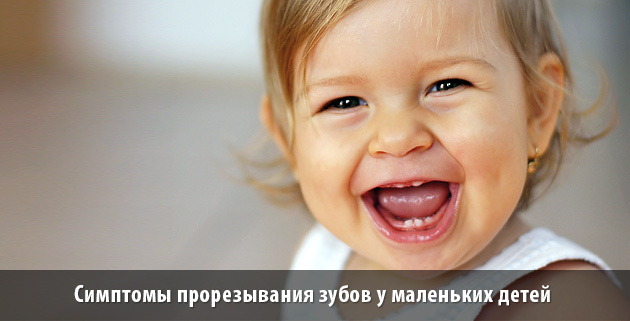
As soon as the moment of the appearance of teeth comes, parents may notice a small white line on the child's gum, and if you gently tap it with a spoon, you can hear a characteristic clatter.
Some pediatricians, in addition to the above symptoms of teething, call a few more signs:
- Temperature increase. In most cases, in children, the temperature does not rise above 38-39 C and does not last longer. 1-2 days. If the temperature is too high and lasts for several days, then you should definitely consult a doctor. An increase in body temperature is not always a symptom of teething: sometimes it means that the child is sick;
- The appearance of diarrhea. When a baby starts teething, salivation increases and he swallows too much saliva. This explains the changes in the work of his intestines. As a rule, diarrhea in a child occurs 2-3 times per day, and the disorder itself lasts 1-2 days;
- The appearance of a runny nose. This is due to the fact that the secretion of mucus by the glands of the nasal cavity also increases. Usually babies "flow from the nose" no more than three days, and the liquid itself is transparent and liquid.
How does the gel help when teething?
Most gum gels contain a local anesthetic. Thanks to him, the child feels relief. You need to apply such a gel to the places of teething with a cotton swab.

Depending on the constituent components, all gum gels can be divided into three types:
- A cooling gel that contains lidocaine, which helps reduce pain on the child's gums. It is necessary to apply such a gel no later than 30 minutes before feeding the baby;
- Anti-inflammatory gel, which also has an antimicrobial and analgesic effect;
- Homeopathic gel based only on natural ingredients, such as herbs.
A "device" like this will also help. It acts as a kind of gum massager and makes life much easier for a little whiny.
Choosing the best tooth gel for pain relief and ease of eruption
When choosing a baby gel for teething relief, it is important to remember that it cannot be universal. Each child is individual, and if one child for wellness it is enough to smear the gums with a homeopathic remedy, then another needs a gel with an anesthetic effect to calm down.
We have prepared a review of drugs that will help the baby survive this difficult period. And although in most cases modern medicines differ from each other only in name, it is worth recognizing that the range of teething gels is quite wide.
Kamistad Baby Gel
 Antimicrobial, analgesic and anti-inflammatory gel for gums, which includes a decoction of chamomile and lidocaine hydrochloride. Chamomile relieves inflammation and promotes the healing of wounds in the mouth, and lidocaine quickly relieves pain. It is allowed to use the gel from 3 months, but the treatment of children under 12 years of age should be carried out under the supervision of a physician.
Antimicrobial, analgesic and anti-inflammatory gel for gums, which includes a decoction of chamomile and lidocaine hydrochloride. Chamomile relieves inflammation and promotes the healing of wounds in the mouth, and lidocaine quickly relieves pain. It is allowed to use the gel from 3 months, but the treatment of children under 12 years of age should be carried out under the supervision of a physician.
Also, due to the high content of lidocaine, it is forbidden to apply Kamistad Baby Gel more than 3 times a day. The gel is also used to relieve irritation in the oral cavity when using braces or prostheses, as well as to treat the oral mucosa.
Dentinox
 This yellowish gel contains chamomile tincture, mint decoction, polidocanol, lidocaine hydrochloride, and auxiliary components.
This yellowish gel contains chamomile tincture, mint decoction, polidocanol, lidocaine hydrochloride, and auxiliary components.
If Dentinox is used for preventive purposes, it will help the child to painlessly endure the formation of incisors and other milk teeth. This remedy eliminates inflammation of the oral mucosa and irritation of the gums. Dentinox is contraindicated in children with fructose hypersensitivity, as it contains sorbitol. Side effects include skin rash and itching. In this case, stop using the drug and consult a doctor immediately.
Calgel
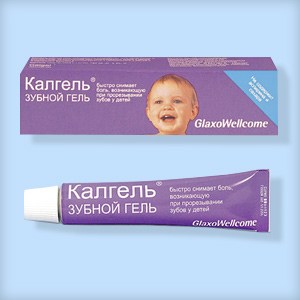 This gel has not only analgesic, but also antimicrobial action. Basically, it should be used to eliminate pain in a child during teething. The main features of this drug are as follows: the gel cannot be used for children under 5 months old, it should be applied to the gums no more than 5-6 times a day.
This gel has not only analgesic, but also antimicrobial action. Basically, it should be used to eliminate pain in a child during teething. The main features of this drug are as follows: the gel cannot be used for children under 5 months old, it should be applied to the gums no more than 5-6 times a day.
In this case, more than 20 minutes should elapse between applications of the product. Contraindications to the use of Calgel are hepatic, cardiac or renal failure, arterial hypotension, hypersensitivity to the components of the drug.
Holisal
 Unlike other gum gels that contain lidocaine, the action of Holisal-gel is aimed at eliminating the cause of pain, in this case- This is inflammation and swelling of the gums. The main components of the drug are choline salicylate and cetalkonium chloride, and the auxiliary ones include anise seed oil, glycerol and others.
Unlike other gum gels that contain lidocaine, the action of Holisal-gel is aimed at eliminating the cause of pain, in this case- This is inflammation and swelling of the gums. The main components of the drug are choline salicylate and cetalkonium chloride, and the auxiliary ones include anise seed oil, glycerol and others.
Thanks to the active substances, tissue swelling is reduced and the pain disappears. The effect is achieved 2-3 minutes after applying the gel. One application of the remedy to eliminate unpleasant sensations is “enough” for 7-8 hours. The drug is contraindicated in babies with hypersensitivity to salicylates and other substances that make up Cholisal.
Can there be allergic reactions?
Before using gels for gums, you need to make sure that the baby's anxiety is caused precisely by the process of growing teeth. If this is true, then the use of the gel will greatly alleviate the condition of the child. However, in the event that the child is extremely sensitive to any components of the drug or is prone to allergies, then before using the gel, it is necessary to consult a pediatrician. This is important, since not all gum gels are hypoallergenic: many of them contain substances that can cause an allergic reaction in the crumbs.
The period of development at which teeth erupt usually proceeds in young children is not at all easy. Each baby behaves differently: someone is naughty 24 hours a day, someone suffers from high fever, poor appetite and stool disorders. There are lucky people who feel great, and their teething is asymptomatic. But this is more an exception to the rule than the norm. Manufacturers of products for children have tried to make life as easy as possible for babies and their parents and have released special gels for gums that help teeth erupt without unnecessary suffering and tears. From now on, moms and dads are faced with the question of which teething gel is better?
In what cases is it worth buying a gel?
Symptoms of teething are quite extensive. Parents are not always able to understand that the appearance of this or that symptom is due to the fact that the baby will soon acquire teeth. Pediatricians advise to carefully look at the crumbs in the following cases:
- The child begins to behave restlessly. Infants demonstrate a deterioration in well-being by crying or screaming, while such a condition can be observed far from 24 hours a day, but periodically;
- The gums become swollen and red;
- The most common is high fever. Thus, the body reacts to eruption. In this case, parents should pay attention to gels that relieve inflammation;
- The child begins to taste everything that comes along the way: from his own fingers to toys. This is due to the fact that the gums begin to itch. A special teether, which must always be kept clean, will help alleviate this condition;
- Profuse salivation. It is advisable to constantly clean saliva so that irritation and redness do not appear on the skin;
- Appetite disappears and sleep worsens. Baby and constantly waking up in the middle of the night. Poor appetite is associated with the fact that it is painful for the child to eat. The most optimal option is the use of gels with an analgesic effect;
- The baby begins to touch his face and ears, as the pain extends not only to the gums;
- There is a cough caused by a large amount of saliva. Cough can also be allergic or cold, so this symptom is not so obvious;
- Hematomas on the gums, eliminated with a cold compress.
Types of gels
Anesthetics in the composition of the gels eliminate pain, thereby facilitating the condition of the baby. Components of plant origin do an excellent job of eliminating pain and are in no way inferior in their effectiveness to their counterparts with a less natural composition. The composition depends on the type of gel and on the purpose for which it is used.
Gels are classified as follows.
Antiseptic gels that relieve inflammation,
Gels that disinfect and kill pathogenic bacteria. These funds act only at the site of application. Do not allow the development of pathogenic flora. It is undesirable to apply such antiseptic preparations to the gums more than 6 times a day.
Anesthetic gels
The main active ingredient in them is a local anesthetic, for example, lidocaine hydrochloride. Relief comes almost instantly. In the gels of some manufacturers, various components are added to enhance the therapeutic effect, for example, homeopathic ones. The period of tooth growth is almost asymptomatic if there is this drug in the home medicine cabinet.
homeopathic
Gels made from natural ingredients of plant origin. They are also called homeopathic.
How to use these drugs
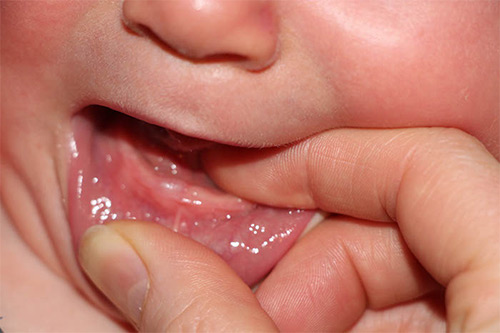
Each gel pack contains detailed instructions for use, which should be read carefully before use. Teething gels may have age restrictions, if neglected, the effect may be unexpected, because the body baby vulnerable and sensitive. Parents should follow these guidelines:
- Use only for very severe discomfort;
- Gel for gums is applied every three hours, but you should not use it more than five times a day;
- To achieve the desired effect, it is enough to apply the gel quite a bit;
- Wash your hands thoroughly with soap before the procedure;
- The drug can be applied both with a finger and with a cotton pad, while it is good to massage the gums.
The use of gels is necessary only at the age of one, in other periods of life, teeth appear less painfully.
Overview of the most popular gels
Each tool should be selected taking into account individual characteristics. Sometimes a gel will help alleviate the condition, based on only components of natural origin, but sometimes you can’t do without those that have a strong anesthetic effect.
The modern pharmaceutical industry produces the following types of gels.
Dentinox
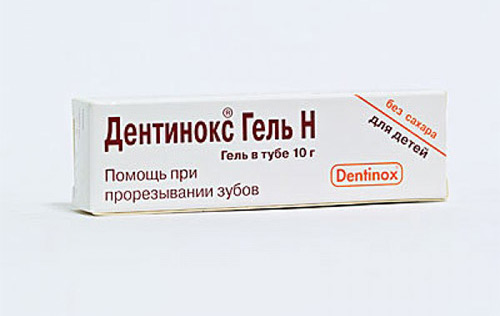
This drug consists of 3 components. It relieves pain, eliminates inflammation and irritation. Dentinox contains an anesthetic and chamomile extract. This gel practically does not cause side effects, so it can be used when it reaches 4 months.
The tool is also suitable for teething wisdom teeth in adults. Dentinox should be used with caution in people who have fructose intolerance. Baby teething gel should not be applied to damaged gums.
Calgel

This is a combined remedy, so the gel relieves the painful condition during teething quite well. The base is lidocaine hydrochloride. During the application of Calgel, the baby is not afraid of severe pain due to the cooling effect of the main component of the drug.
The drug is approved for use only after 5 months. The main advantage of Calgel is that the therapeutic effect occurs instantly. However, the likelihood of allergic reactions is high. This remedy is available by prescription.
Kamistad baby

Designed for babies, has a composition that does not harm the baby's body if accidentally swallowed. Not recommended for use in children under three months of age. The effect of the gel is exclusively anesthetic.
There is an analogue of the drug intended for adults and adolescents. It is great for teething wisdom teeth. Kamistad is both an anti-inflammatory and analgesic. The gel is allowed to be used only from the age of twelve. You can buy the product without a prescription. Kamistad does not affect driving in any way.
Holisal
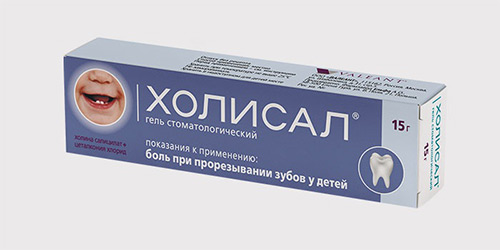
It is an excellent antiseptic. It copes well with unpleasant symptoms, such as swelling. The drug is well absorbed through the skin into the bloodstream. Holisal is safe, it can be safely used by lactating and pregnant women.
The gel contains anise, this plant component increases salivation, which, when teething, already gives the baby a lot of inconvenience. Therefore, the drug is not recommended for use in this case. However, if there is a threat of inflammatory processes in the oral cavity, the gel will cope with them perfectly.
This drug has an average cost. It should not be used by people who are hypersensitive to acetylsalicylic acid.
Dentol baby
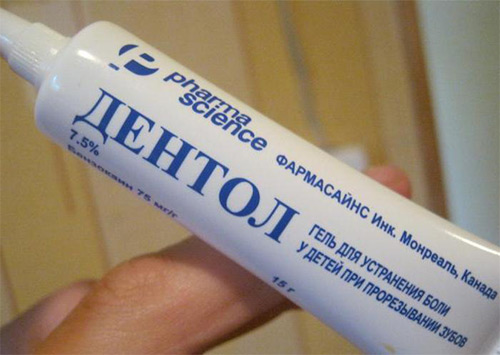
This is a gel that is allowed to be used for pain relief from the age of four months. Dentol is not recommended to be applied to the gums for no more than seven days and no more than 4 times a day. The active ingredient is benzocaine. The effect is analgesic.
The gel is inexpensive, while it is quite safe. The presence of inflammation and damage in the oral cavity is a reason to abandon Dentol and pay attention to other means, for example, Holisal.
baby doctor

Baby Doctor refers to homeopathic medicines. It is shown to very young children. Parents can not be afraid to use it, because it contains only natural ingredients. Removal of pain and inflammation occurs almost instantly. It can be applied as needed. But the presence of ingredients of plant origin does not exclude the possibility of allergic reactions.
Pansoral 1st teeth

This gel is great for the appearance of the first milk teeth. This gel softens and soothes inflamed gums. It contains only extracts of medicinal plants. Pansoral is approved for use from the age of four months. The therapeutic effect of this remedy, although insignificant, can be used without fear, since there are practically no restrictions. Few drugs can boast of this.
In order not to get confused in a wide range of products of this pharmaceutical group, below is comparison table, which will help determine which gel is best for teething:
| Name | Action | Advantages | disadvantages | Compound | Price |
| Dentinox | Combined agent, gel eliminates pain and prevents the development of inflammation in the oral cavity | Fast action | Not recommended for breastfeeding, used lidocaine often causes allergies | Polidocanol, lidocaine hydrochloride, chamomile extract | 300-350 rubles |
| Calgel | Cools, relieves pain and inflammation, teeth erupt less painfully | Instant action | The effect lasts no more than an hour and a half | Lidocaine, cetylpyrimidinium chloride | 340-360 rubles |
| Kamistad | Local anesthetic relieves pain, while chamomile disinfects, reduces inflammation and promotes rapid healing | The presence of herbal ingredients | Eliminates pain for a short time | Lidocaine hydrochloride, chamomile officinalis | 200-220 rubles |
| Holisal | Fights the inflammatory process, eliminates puffiness. The action lasts almost ten hours, while the gel is not washed off under the influence of saliva. The drug fights pathogenic microflora, protects the oral cavity from harmful bacteria. | No lidocaine, can be used during lactation, long-lasting effect | Only antiseptic action | Choline salicylate, cetalkonium chloride, anise | 300-320 rubles |
| Dentol baby | Quickly anesthetizes, the action lasts about a couple of hours. | Instant effect | short duration | Benzocaine | 190-210 rubles |
| baby doctor | Plant extracts are good for reducing inflammation and soothing irritated gums. | Components of plant origin | Virtually no pain relief | Calendula, chamomile officinalis, echinacea, plantain, marshmallow | 320-350 rubles |
| Pansoral first teeth | Soothing effect, softens the gums | natural composition | Briefly relieves pain | Saffron, marshmallow, chamomile | 360-380 rubles |
- And now you can no longer afford to wear open swimsuits and short shorts ...
- You start to forget those moments when men complimented your flawless figure...
- Every time you approach the mirror, it seems to you that the old days will never return ...
Every parent is familiar with the unpleasant symptoms of baby teething. Endless whims, sleepless nights, refusal to eat - all this is very exhausting for both the baby and his mother. During this period, the child especially needs the help and support of parents. All kinds of devices to facilitate eruption do not always work. Sometimes the pain in the gums is so severe that touching something causes even more discomfort. In such cases, gum gel is used during teething. Komarovsky confirms the need for the use of gels.
How to understand that a child is teething?
There are many symptoms of teething in children, but they usually do not appear all at once. Some babies show only one or two clear signs of an imminent appearance of a tooth.
What are the main symptoms of the imminent appearance of a tooth?
- Irritability and capriciousness of the baby.
- Swelling and redness of the gums.
- Increase in body temperature.
- The child pulls all nearby objects into his mouth, including fingers (this happens due to itching of the gums).
- Increased salivation (sometimes this can lead to irritation around the mouth).
- Small cough (caused by increased salivation).
- Violation of the daily routine: poor sleep, lack of appetite, refusal of solid food.
- Pain and bruising on the gums.
- Rubbing the baby's ears, cheeks (be careful, this can also indicate pain in the ear).
- Diarrhea.
If you notice symptoms in your child this list You can be sure that the baby is teething. Teething gum gel is what you need right now.
How does the gel work?
Gels for teeth have a mild local anesthetic and cooling effect. When you apply a small amount of the product (with a clean finger or a cotton pad) to the gum, the child will feel better.
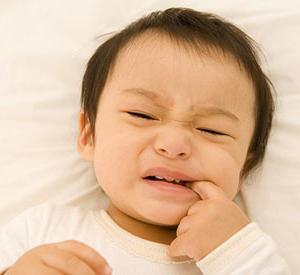
Always remember that baby teething gum gel is a drug and should not be abused! All drugs work for about 20 minutes, but they should not be used too often. The permissible number of applications of the gel for babies is 6 times a day. And remember that the gel will not speed up the appearance of a tooth, it will only help to calm the capricious baby for a while.
Gel for teething gums: which one is better?
All teething gels are divided into groups depending on the main substance and its action. Gels are cooling (Kalgel, Kamistad, Dentinoks), homeopathic (Baby Doctor) and anti-inflammatory (Cholisal). Which of the drugs to choose depends only on the condition of the child, his age and the symptoms associated with teething.
If you do not know which product is best for your baby, ask your doctor about this question, he will help you choose the right gum gel for teething babies. The list of popular gels is known to every pediatrician. Consider the use of each of the gels in more detail.
"Kalgel"
"Kalgel", being a cooling agent, quickly relieves the pain associated with teething in a child. You can use this gel 6 times a day and not earlier than after the baby reaches the age of five months. It is worth noting that the list of contraindications for the drug is quite impressive, it includes renal, hepatic and heart failure, bradycardia, hypotension and hypersensitivity to the components (cooling gels often cause urticaria).

Reviews about the drug are different. It perfectly relieves itching and pain, but the antiseptic that is part of Kalgel can destroy some beneficial microorganisms.
"Kamistad"
The gel called "Kamistad" has a complex effect: it perfectly anesthetizes and has an antiseptic effect (thanks to the chamomile that is part of it). Gel for gums during teething "Kamistad", the instruction of which is not very different from the previous drug, is a high-quality and effective remedy. Its use is allowed from three months.
"Dentinox"
Dentinox is one of the most popular gels used by parents to ease teething in babies. This gel includes lidocaine, chamomile extract and polidocanol 600. "Dentinox" is a gel for teething gums in babies, reviews of which are most often only positive. Since this preparation contains a small amount of lidocaine, the list of contraindications is limited only by hypersensitivity to the components contained in the gel. The medicine can not be used more than three times a day, most often it is used during children's sleep.
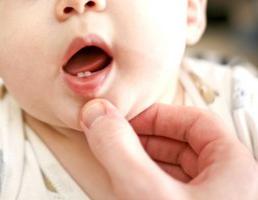
"Holisal"
Gel "Cholisal" does not contain lidocaine and has an antimicrobial, analgesic and anti-inflammatory effect. The positive effect of the gel is achieved by removing swelling from the gums. When the product is applied, the baby can feel discomfort burning sensation in the mouth, but it will not last longer than three minutes. Gel for gums during teething "Cholisal" is not washed off by the saliva of the child. The effect of the analgesic effect can last up to 8 hours, which parents really like. It is possible to use the gel even before meals (which is a luxury for other gels).
"Baby Doctor"
"Baby Doctor" is a homeopathic gel consisting of natural and hypoallergenic ingredients. It contains extracts of such plants as calendula, chamomile, plantain. The drug quickly helps the baby and soothes the pain and itching in the gums. The composition of the product is completely natural, which allows you to use it an unlimited number of times a day. The drug has no side effects, its use is allowed for children with allergic reactions. If you are looking for a teething gum gel for babies at 4 months, then Baby Doctor is perfect for you. The advantages of the drug include its ability to restore the delicate mucous membrane in the child's mouth.

- Never forget about the need to carefully study the instructions before using the drug.
- Do not forget about age restrictions, strictly follow them. Do not use a gel approved from one year old for an 11 month old baby.
- Do not use lidocaine gel on breastfed babies. These medications can make sucking difficult. If the use of the gel is necessary, use it long before the baby eats.
How to help a child with folk remedies?
If your baby's teething symptom is not too pronounced, you can first try to help him without the use of dental gels. What are the safest methods to alleviate the condition of the dentist?

Often exhausted parents are interested in how long the process of teething takes. There is no clear answer to this question, because it is individual and for each baby the duration of the appearance of a tooth can be different. Someone is capricious for only a couple of days, while someone has to suffer for weeks. Do not worry, most often only the first teeth cause such problems, and then the dentition is not so painful.
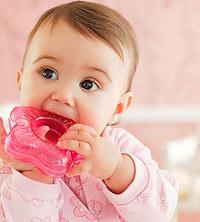
In any case, use gum gel when teething, but do not forget about the psychological side of communication with the baby. Hold him in your arms more often, do not yell at the child, even if you are very tired. He feels your irritation and is naughty even more. Distract the baby with toys, music and conversations, your love and warmth to him in this moment vital!
